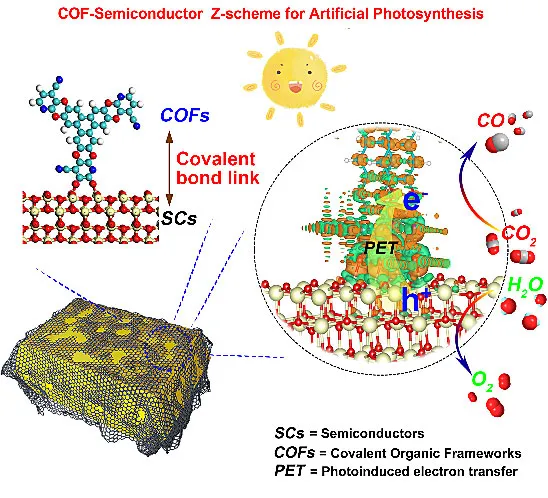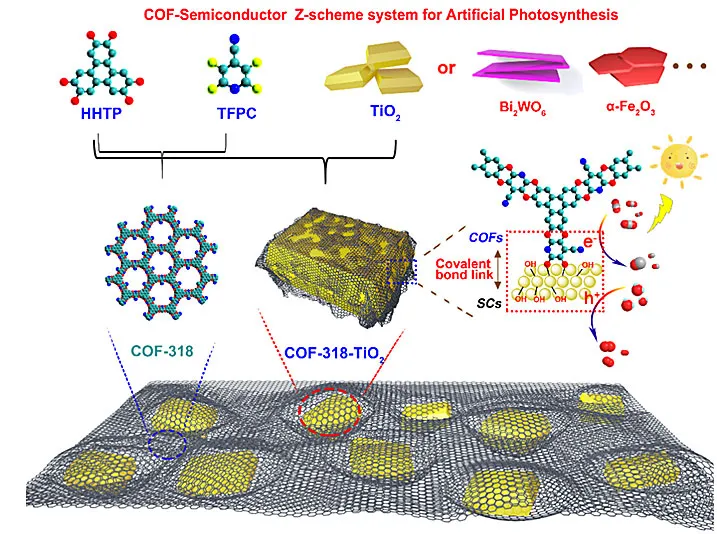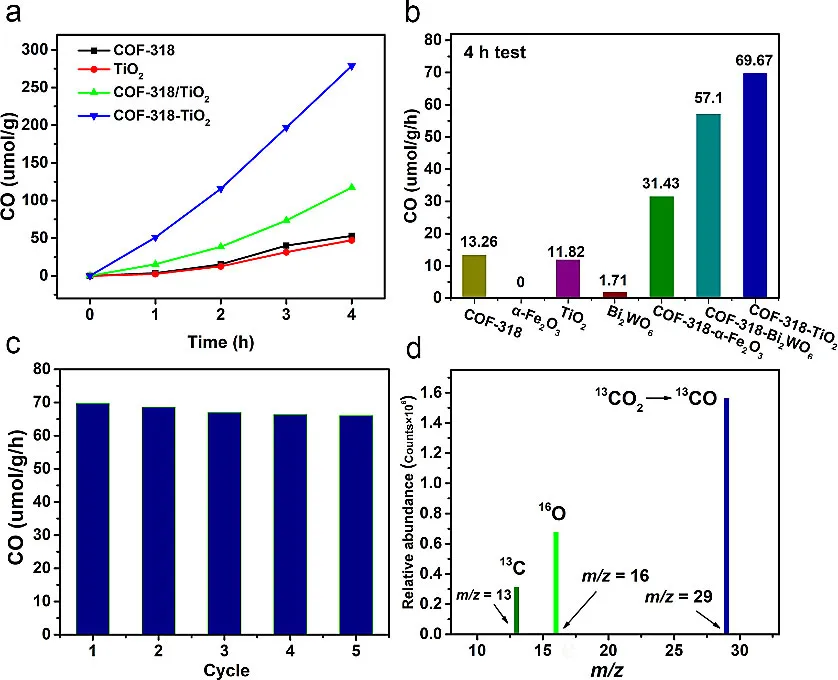[Catalysis] Inorganic semiconductor-crystalline covalent organic framework Z-Scheme heterojunction for artificial photo-synthesis
QQ Academic Group: 1092348845
Detailed
In the field of artificial light synthesis, it is one of the most challenging photocatalytic reactions to achieve CO2 photoreduction with water as a sacrificial agent driven by visible light. Therefore, designing and synthesizing effective photocatalysts to achieve this reaction is crucial. Recently, the research group of Professor Lan Yagan of Nanjing Normal University designed and synthesized a series of Z-Scheme isomorphisms composed of crystalline covalent organic frameworks (COF-318, COF-316) and inorganic semiconductors (TiO2, Bi2WO6 and α-Fe2O3) Catalysts for solidified composite materials. These composites can achieve efficient CO2 photoreduction reactions using water as an electron donor, without the need for additional photosensitizers and sacrificial agents. Driven by visible light, this Z-Scheme heterojunction catalyst achieves efficient electron-hole separation and transfer between COF and oxide semiconductors under photoexcitation and effectively reduces and oxidizes CO2 occurring on COF through covalent bonds. Water oxidation reactions on the semiconductor are connected in series (Figure 1).

FIG. 2 is a schematic diagram of synthesizing a COF-semiconductor heterojunction material using COF-318 and oxide semiconductors TiO2, Bi2WO6, and α-Fe2O3.

The authors first determined the structure of the synthesized COF-oxide semiconductor heterojunction material. The authors confirmed the successful synthesis of crystalline COF-318 and COF-318-TiO2 by powder diffraction. X-ray photoelectron spectroscopy (XPS), Fourier transform infrared spectroscopy (FTIR) and density functional (DFT) calculations proved the covalent bond between COF-318 and TiO2. From the transmission electron micrograph of COF-318-TiO2, we can see that TiO2 in the composite is completely covered by COF-318, which also shows from the side that there is a strong interaction between TiO2 and COF. The COF-oxide semiconductor heterojunction material was used as a catalyst. Under visible light, the photocatalytic test was performed under saturated CO2 and water vapor (gas-solid reaction, without the addition of additional photosensitizers and electronic sacrificial agents). Figure 3 is a graph of the CO2 photoreduction performance of a COF-oxide semiconductor heterojunction material, where the COF-oxide semiconductor heterojunction can efficiently photocatalytically convert CO2 to CO under experimental conditions, with a selectivity close to 100%, and After 4 hours, the CO production reached 278.7 μmol g-1. At the same time, water as an electron donor undergoes a half-oxidation reaction with water to generate oxygen. The authors also investigated the cycle stability of this catalyst and the results show that the performance is only reduced by about 5% under five cycle tests. The author also used isotopic calibration method combined with GC-MS to confirm that CO in the product was derived from CO2 and O2 was derived from H2O.

In summary, this work innovatively developed a strategy for covalently connecting a crystalline covalent organic framework (COF) with an inorganic oxide semiconductor. A stable organic-inorganic Z-type heterojunction was obtained and successfully used for artificial photosynthesis. . This work provides an important example study and new strategy for the development of efficient and stable crystalline material photocatalysts for artificial photosynthesis. The related paper was published in Angew. Chem. Int. Ed., The corresponding author is Professor Lan Yagan of Nanjing Normal University.
Source: X-MOL Information

Figure 1. COF-semiconductor Z-Scheme for artificial light synthesis
FIG. 2 is a schematic diagram of synthesizing a COF-semiconductor heterojunction material using COF-318 and oxide semiconductors TiO2, Bi2WO6, and α-Fe2O3.

Figure 2. Synthesis and structure of a COF-oxide semiconductor heterojunction
The authors first determined the structure of the synthesized COF-oxide semiconductor heterojunction material. The authors confirmed the successful synthesis of crystalline COF-318 and COF-318-TiO2 by powder diffraction. X-ray photoelectron spectroscopy (XPS), Fourier transform infrared spectroscopy (FTIR) and density functional (DFT) calculations proved the covalent bond between COF-318 and TiO2. From the transmission electron micrograph of COF-318-TiO2, we can see that TiO2 in the composite is completely covered by COF-318, which also shows from the side that there is a strong interaction between TiO2 and COF. The COF-oxide semiconductor heterojunction material was used as a catalyst. Under visible light, the photocatalytic test was performed under saturated CO2 and water vapor (gas-solid reaction, without the addition of additional photosensitizers and electronic sacrificial agents). Figure 3 is a graph of the CO2 photoreduction performance of a COF-oxide semiconductor heterojunction material, where the COF-oxide semiconductor heterojunction can efficiently photocatalytically convert CO2 to CO under experimental conditions, with a selectivity close to 100%, and After 4 hours, the CO production reached 278.7 μmol g-1. At the same time, water as an electron donor undergoes a half-oxidation reaction with water to generate oxygen. The authors also investigated the cycle stability of this catalyst and the results show that the performance is only reduced by about 5% under five cycle tests. The author also used isotopic calibration method combined with GC-MS to confirm that CO in the product was derived from CO2 and O2 was derived from H2O.

Figure 3. Photocatalytic performance of COF-oxide semiconductor heterojunction catalyst under solid-gas reaction conditions
In summary, this work innovatively developed a strategy for covalently connecting a crystalline covalent organic framework (COF) with an inorganic oxide semiconductor. A stable organic-inorganic Z-type heterojunction was obtained and successfully used for artificial photosynthesis. . This work provides an important example study and new strategy for the development of efficient and stable crystalline material photocatalysts for artificial photosynthesis. The related paper was published in Angew. Chem. Int. Ed., The corresponding author is Professor Lan Yagan of Nanjing Normal University.
Source: X-MOL Information
- Previous: MXene fiber refractive
- Next: What is graphene?


 Application
Application
